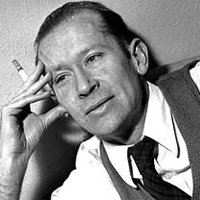Edward Estlin Cummings - Biography and Works
Edward Estlin Cummings is an American poet of great lyrical intensity. He was a son of an English professor at Harvard who was later pastor of the Old South Church in Boston. Cummings took his B.A. and M.A. at Harvard, and then joined the Norton Harje Ambulance Corps in France during World War I. After the war, he lived in Paris and studied painting, then settled in New York's Greenwich Village with other writers and artists, continuing to paint and to write poetry.

E. E. Cummings (1894-1962)
His idiosyncrasy as an artist is quite obvious even in the way he spells his name without any capital letters. He was once imprisoned in a French concentration camp for three months because he refused to say that he hated the Germans. His novel, The Enormous Room (1922), is a result of this experience. He published his first volume of poetry, Tulips and Chimneys, in 1923. He writes about family and traditional virtues. He dislikes cold rationality and condemns the inhumanity of science and technology. All that matters to him is poetry to which he devoted his whole life.
Cummings was a soldier and an ambulance driver during the First World War, but because of his ‘humanistic’ and anti-war ideas, and letters and poetry he was imprisoned. Cummings later wrote a novel about the experience of being imprisoned and became famous. He studied painting and his poetry was always influenced by the shapes and colors; he makes us see the words by violating common norms of spelling and grammar. A number of his poems deal verbally with visual ideas with attempts to articulate visuals thinking and bring into poetry the aesthetic principles of the painters.
In theme also, Cummings goes against traditional ideas of greatness and heroism, the savage ‘glory’ of war, and false ideas. Irony and satire are usually there in his poems, but they are very implicit, and though his subjects are common his ideas are very original.
Cummings developed an innovative, playful poetic style, flaunting the rules of syntax, grammar, and punctuation in order to make us see the words and their relationships in a new way. In the form of his poetry and in his themes, he strikes out against conformity, and celebrates the vitality of human love. He is not a poet of ideas, but he is one of the most joyful singers of the traditional themes of love and spring, as well as one of the sharpest satirists in modern poetry.
Cummings poetry includes the use of capital letters and punctuation in the middle of single words, phrases split by parentheses, and stanzas arranged to create a visual design on the page. Formal devices were often used as visual manifestations of theme or tone; the poem’s typographical dimension itself becomes a new level of meaning.
Cite this Page!
Sharma, K.N. "Edward Estlin Cummings - Biography and Works." BachelorandMaster, 4 Nov. 2013, bachelorandmaster.com/biography/edward-estlin-cummings.html.
Related Topics
Buffalo Bill's: Summary and Analysis
For Prodigal Read Generous: Summary and Analysis
i sing of Olaf glad and big: Summary and Analysis
my father moved through dooms of love: Analysis
anyone lived in a pretty howtown: Analysis
in Just-spring: Summary and Analysis
since feeling is first: Summary and Analysis
O Sweet Spontaneous: Summary and Analysis
 |
bachelorandmaster.com |